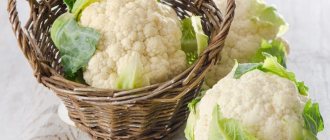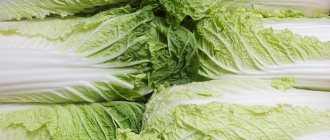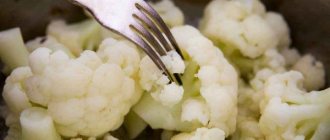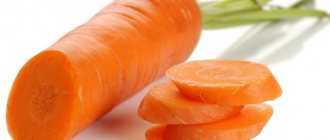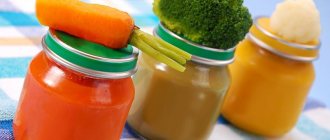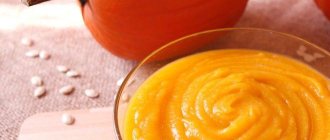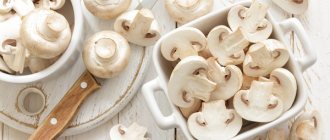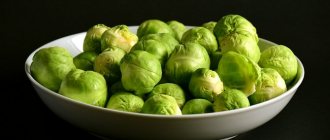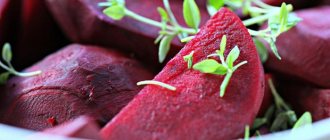Home / Fruits
Back
Published: 04/26/2020
Reading time: 13 min
0
1
- 1 Cauliflower in baby's complementary feeding: when and how to give it?
- 2 Benefits for the child’s body
- 3 From how many months can you give
- 4 How to cook correctly
- 5 Broccoli in complementary foods
- 6 Recipes with cabbage for children
- 7 How to freeze for the winter 7.1 Cabbage soup for kids
- 7.2 Stewed cabbage
- 7.3 Casserole
- 10.1 Bloating
Cauliflower in baby's complementary feeding: when and how to give it?
You can give your child factory-made cauliflower puree or prepare it yourself at home. It is not difficult to prepare and very quickly.
Before cooking, cabbage purchased at the market or in a store must be soaked in cool, salted water for half an hour. This will clean the vegetable from possible nitrates, small insects and their larvae.
To prepare the puree, you need to boil 3-4 small inflorescences and grind with a blender until smooth. You can dilute the puree to a more liquid consistency with the decoction in which the inflorescences were boiled, breast milk or a mixture.
From 8-9 months you can add butter, potatoes, and egg yolk to the dish.
The introduction of white cabbage into the diet usually begins at 7-9 months, but only after the child becomes familiar with the taste of vegetables such as carrots, pumpkin, potatoes, cauliflower, broccoli, and zucchini. But for now it is customary to only add it to other purees.
As an independent dish, fresh white cabbage is offered to children from the age of three (the product must be chewed well, which a one-year-old baby practically cannot do).
It is worth noting that it is forbidden to use the stalk as food because of its poisonousness and toxicity (it is in it that harmful substances that are used by gardeners when growing vegetables accumulate).
The first complementary foods are introduced from 6 months. It is not recommended to introduce foods earlier. The child’s body is simply not ready for other foods. It can cause serious gastrointestinal problems, allergies, and constipation.
For breastfed children, complementary feeding is not required early and is not required at all, because your milk contains the entire range of nutrients and nutrients necessary for growth and development.
The baby grows, and his needs grow with him. But mother's milk still remains the basis of a child's nutrition for up to a year.
A new product is introduced to the menu in the morning or afternoon.
This allows you to track the body's reaction. For the first time, the tip of a teaspoon is enough, or 1-2 microdoses of the product. If no negative reactions are observed, the next day the portions are slightly increased.
But if allergies or problems with the digestive tract appear, the product is administered again after about 1-2 weeks.
It is with this type of vegetable that most mothers begin complementary feeding. Cauliflower is one of the first to be introduced into a child’s diet. And all this thanks to the fact that:
- it does not cause allergies;
- does not cause bloating, since it contains less fiber than white cabbage;
- it is rich in vitamins (A, B, C, E, K, H, PP), minerals (phosphorus, iodine, potassium, iron, magnesium);
- it helps strengthen bones;
- improves metabolism;
- contains vegetable protein that improves the functioning of the liver and gall bladder;
- strengthens the walls of blood vessels.
Cauliflower is suitable for first feeding.
You can buy ready-made puree, or you can make it yourself.
Homemade puree is easy to prepare: you need to take 1 inflorescence and boil it in boiling water for 5-10 minutes. Then mash with a spoon or pass through a blender and that’s it, the complementary foods are ready.
At what age can a child eat cauliflower? Starting from the moment complementary foods are introduced, namely from 6 months, cauliflower complementary foods can be introduced into the baby’s diet. If there is no reaction from the body, then you can gradually increase the portion.
Broccoli, like cauliflower, is great for first feeding. They do not contain coarse fiber, so they are better digested and do not cause bloating. Broccoli rarely provokes allergies.
The composition of broccoli is rich in vitamins (A, B, C, E, PP), amino acids. It contains a lot of protein. And since there is no cholesterol in broccoli, this protein is really beneficial for the body.
Broccoli is good for overweight children because it is low in calories. The composition contains a lot of fiber, which helps fight constipation.
Due to the high content of folic acid in broccoli, it is recommended not only for children, but also for women planning pregnancy.
Broccoli puree
Casserole
- Cauliflower – 0.5 kg;
- Milk – 1 glass;
- Eggs – 2 pieces;
- Grated cheese – 100 g;
- Greens and salt to taste.
Prepare and cook the cabbage. Beat the eggs and pour in the milk, stir, add salt if necessary. Pour the resulting mixture over the cabbage, sprinkle cheese on top and bake until golden brown at two hundred degrees.
Cutlets
- Cauliflower – 0.5 kg;
- Flour – ¼ cup;
- Egg – 1 pc.;
- Chopped parsley – 1 tbsp. spoon.
Boil and chop the cabbage, break the egg, add flour and parsley. Mix well and form into small patties or meatballs. Fry in vegetable oil until tender or steam. These cutlets are good served with buckwheat, pasta or rice, or mashed potatoes.
Vegetable puree soup
- Cauliflower – 250 grams;
- Broccoli – 250 grams;
- Carrots – 1 pc.;
- Potatoes – 2 tubers;
- Greens to taste.
Prepare and boil the vegetables separately, cut and grind in a blender. Add finely chopped greens, pour in the broth after the cabbage and stir. For babies older than eight months, you can add chopped meat or fish to the soup.
Products must be prepared separately, since meat and fish broths are not recommended for small children. When cooked, meat and fish release extractive substances that negatively affect digestion.
- Chicken fillet – 100 g;
- Cauliflower – 300 gr;
- Onion – ½ piece;
- Carrots – 1 pc.;
- Zucchini – 1 medium fruit;
- Tomatoes – 2 pieces;
- Green peas – 150 gr.;
- Low-fat sour cream - 4 tablespoons. spoons.
This recipe is suitable for children over one and a half years old. Cook the chicken separately and cut it. Finely chop the onion and carrots and simmer in vegetable oil. Prepare the zucchini and cabbage, peel the tomato, chop and add to the onions and carrots.
Cauliflower is also good for a nursing mother. A safe vegetable can be introduced into the diet in the first week of breastfeeding. Read about the benefits of cauliflower during lactation at the link https://vskormi.ru/mama/cvetnaya-kapusta-pri-grudnom-vskarmlivanii/.
Cauliflower is a low-allergenic product, ideal for the first feeding of infants and the diet of a nursing mother.
Beneficial properties of cauliflower:
- Vitamin K is necessary for normal blood clotting in a child; it maintains normal water-salt balance, blood pressure levels, and a healthy heart rhythm in the body. Vitamin K is also an indispensable aid in the absorption of calcium and vitamin D.
- Calcium contributes to the normal development of the baby's skeletal system.
- Fiber, which is part of cauliflower, has a light, delicate structure and is perfectly absorbed by the child’s body. It improves the digestion process and normalizes the frequency of bowel movements. Regular consumption of cauliflower helps prevent constipation and gas formation.
- Manganese contributes to the normal functioning of the nervous system and the development of muscle and bone tissue.
- Plant protein activates the activity of the gallbladder and liver.
- Ascorbic acid is involved in many metabolic processes, strengthens the child’s immune system, etc.
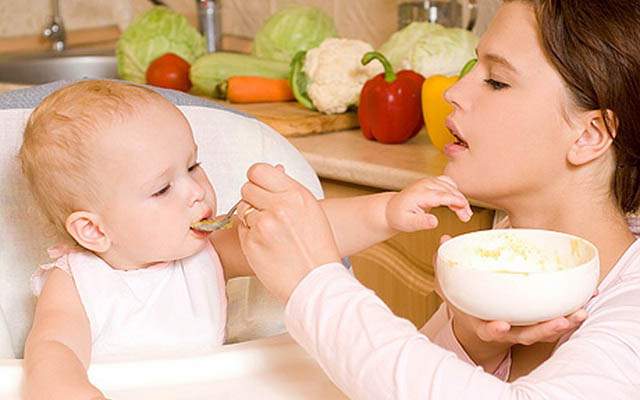
Cauliflower can be harmful only in certain cases:
- in case of individual intolerance to the product;
- for diseases of the thyroid gland;
- with an excessively acidic reaction of gastric juice;
- with urolithiasis;
- for stomach upsets;
- in the period after surgical treatment.
Cauliflower as a complementary food is not an allergen for a child, which is why it is one of the first to be introduced into the diet.
Benefits of cauliflower for a baby:
- has a laxative effect, normalizes stool, soothes colic;
- contains cobalt, phosphorus, iron, magnesium and other essential trace elements;
- there is vegetable protein that activates the work of the liver and gall bladder;
- reduces blood sugar levels.
In addition, the product contains citric, folic and malic acids, which strengthen the walls of blood vessels and the heart.
We invite you to familiarize yourself with: Cacti with colored needles: photos, care at home
However, cauliflower for children also has its disadvantages:
- in large quantities causes increased acidity of gastric juice;
- Possible bloating and flatulence.
In exceptional cases, an allergy to cauliflower may occur, which is accompanied by a rash, redness, and upset stool.
It's no secret that vegetables have great benefits for both children and adults. They, along with cereals and fruits, should form the main part of a baby’s diet.
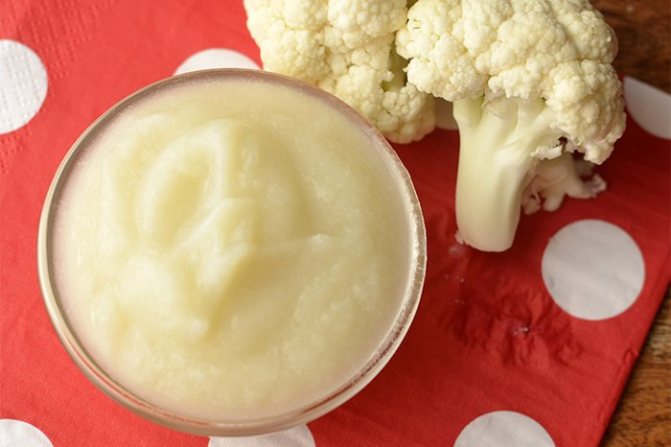
Broccoli contains a huge amount of vitamins C and B, rich in beta-carotene, calcium, iron, potassium and other trace elements. This vegetable not only improves the baby’s vision, but also participates in the fight against pathogenic bacteria, improves blood quality, and prevents constipation due to the fiber it contains.
It’s worth saying more about cauliflower. This vegetable contains large amounts of copper, iron, phosphorus, and potassium. In addition, it is a source of protein, participates in the development of all body systems, and strengthens the walls of blood vessels.
The benefits of this vegetable for babies are invaluable.
- Removes toxins from the body.
- Improves digestion and relieves colic in babies.
- Strengthens the immune system.
- Increases resistance to viral diseases.
- It prevents anemia (a common disorder in infants).
- Participates in cell regeneration.
First of all, it’s worth saying a few words about choosing a product for baby food. For babies, buy only fresh vegetables with a dark green color. Broccoli should be bright, strong, without rot or diaper rash.
Before cooking, rinse the broccoli with boiled water and soak the florets for 3-4 hours. Next, start cooking. For the puree you will need:
- broccoli – 100 grams;
- vegetable oil – 1 teaspoon.
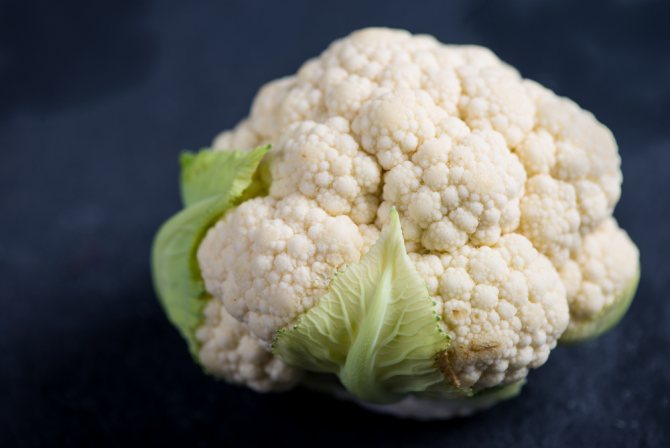
Boil broccoli in boiling water for 15-20 minutes or cook in a slow cooker in the “steam” mode. Grind the finished vegetable in a blender and add oil.
If your baby likes the new taste and does not have an allergic reaction, you can add some potatoes, carrots or cauliflower to the broccoli puree.
Benefits for children's bodies
White cabbage contains vitamins C and E, K and D, group B and rare vitamin U. Little is said about the latter, but with regular consumption it treats gastritis and ulcers, increases intestinal tone and normalizes liver function.
Vitamin D is especially useful for children, as it strengthens bones and prevents rickets. Since this substance is produced by the sun's rays, in regions with little sun, children do not receive enough of this important element.
Cabbage contains an increased concentration of ascorbic acid, which is responsible for immunity and good mood. This vegetable retains vitamin C for up to eight months, which only citrus fruits can boast of.
Cabbage performs the following beneficial functions and properties:
- Accelerates growth and restores cells, forms hematopoiesis;
- Has a beneficial effect on the functioning of the liver, kidneys and other internal organs;
- Normalizes metabolism, the functioning of digestion and intestines, eliminates constipation;
- Heals wounds and improves skin condition;
- Strengthens bones and teeth, heart and blood vessels;
- Cleanses the body of toxins and foreign proteins, waste and excess fluid, relieves swelling;
- Strengthens and supports the immune system, tones the body;
- Restores strength, gives vigor and energy, eliminates fatigue and improves mood;
- Calms and strengthens nerve cells, relieves stress and pain;
- Has a beneficial effect on the condition of the skin of the lips, eliminates cracks on the lips;
- Improves the absorption of iron, proteins and fats in the body;
- Normalizes cholesterol levels and protects against heart disease;
- Stimulates brain function;
- Useful for gastritis, gout and cholelithiasis;
- Increases appetite, but does not contribute to excess weight gain.
Cabbage is low in starch, sucrose and calories. Therefore, it is recommended for diabetes and increased weight. The vegetable is often included in the diet menu. However, it can also cause negative reactions, especially when eaten raw or fried.
This product is absorbed slowly and slowly, increases gas formation and worsens stool. May cause allergies and poisoning, pain and discomfort in the abdomen. To avoid a negative reaction, it is important to properly administer and prepare the product for your baby. Next, we will find out at what age a child can be given white cabbage.
We suggest you familiarize yourself with What to do if you are bitten by a wasp (neck, tongue, hand): first aid
What can you say about the benefits of Brussels sprouts and about them in general?
Brussels sprouts belong to the same cruciferous family as cauliflower, broccoli and even mustard, and its exact origin comes from leaf cabbage, from which Brussels sprouts were developed by Belgian gardeners in the 16th century.
The emerald green heads, about the size of a walnut, grow several dozen on a single stem, forming an elongated cluster surrounded by huge, spreading leaves.
The taste with a sweetish-nutty hue is complemented by a pungent smell, and sometimes notes of bitterness, and all this together creates the extraordinary taste of cabbage, for which Brussels sprouts are so highly valued by gourmets around the world.
In our country, unfortunately, this vegetable is rarely found on sale fresh.
But it is also good frozen, provided, of course, that there has been no defrosting.
Brussels sprouts are prepared in an extremely varied way - added to soups, meat and vegetable stews, fried in breadcrumbs, baked and stewed, added to casseroles and salads.
Theoretically, you can eat it raw, but it just doesn’t taste good, so it’s better to cook it.
The main secret is not to overdo it with the duration of heat treatment in any recipe - this makes the cabbage lose its charm in taste, smells bad and is not so healthy.
The energy value of fresh Brussels sprouts is approximately 40 kcal per 100 g. But, of course, this figure can vary greatly depending on the methods of preparing the vegetable. In any case, it can be recommended for dietary nutrition.
This variety of cabbage is distinguished by its high protein content, and, both in value and in digestibility, it is practically not inferior to proteins of animal origin. Particular benefits in this regard can be obtained from Brussels sprouts if they are consumed in combination with chicken or turkey meat, and it is better to cook the vegetable and meat together so that their composition is maximally combined at the molecular level.
The composition of Brussels sprouts is often described in comparison with the composition of white cabbage and, indeed, there is something to contrast here.
Brussels sprouts contain many times more vitamins E, A and B9, and elements such as phosphorus, magnesium and sodium are absorbed from it much better.
Brussels sprouts are superior to citrus fruits in vitamin C content and compete with black currants. And it is well known how much ascorbic acid means for immunity.
And the combination of this vitamin with cabbage delicate fiber (in effectiveness, however, not inferior to the fiber of whole grain bread) has an extremely positive effect on the digestive system - from reducing the acidity of gastric juice and treating heartburn, to stimulating intestinal function.
Brussels sprouts also contain ash, mono- and disaccharides (valuable sources of energy for the whole body), as well as glucosinolates - a special class of organic compounds, thanks to which this vegetable, no worse than many specialized medicines, strengthens the walls of blood vessels, makes them more elastic and prevents formation of cholesterol plaques.
Separately, it is worth mentioning the benefits of juice squeezed from fresh Brussels sprouts.
Few people like it for its specific taste, but, firstly, it is acceptable to mix it with other fresh vegetable juices, and secondly, sometimes it can be useful to take advantage of a number of its properties:
general strengthening;
· wound healing;
· calming during periods of stress.
Also, it is able to improve the transport of nutrients to cells.
From how many months can you give
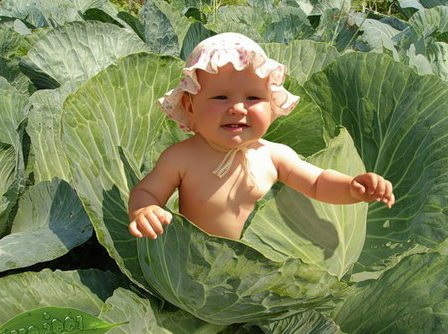
The introduction of cauliflower to infants occurs at the age of 6 months. For the first time, the dose of puree should not exceed 5 grams (1 teaspoon). Cabbage is given in the morning or at lunch, so that later parents can monitor a possible negative reaction from the body (rash, red spots on the skin, diarrhea, bloating).
If there is no discomfort or rash, then the next day the portion is doubled. So gradually the daily volume of puree is increased to 50 grams. At 9-10 months it is 150 g, after a year - 200 g.
How to cook correctly
Not many mothers know how long to cook frozen or fresh cauliflower for their baby so that it retains the maximum amount of nutrients.
Remove leaves from the cabbage head, rinse thoroughly and divide into small inflorescences.
It is advisable to steam the vegetable for your baby. To do this, the inflorescences are placed in a double boiler for 15 minutes. If there is no such device in the house, then it can be welded. The inflorescences are dipped in boiling water and simmered over low heat for 7-10 minutes. Readiness is checked with a fork; the stem should be easily pierced.
Frozen cauliflower is prepared in exactly the same way as fresh. But you shouldn’t defrost it before cooking, otherwise it will fall apart.
Fresh vegetables are considered healthier for children than frozen ones. Because with strong cooling, some of the useful substances are destroyed.
What harm can there be from Brussels sprouts?
Theoretically, excessive consumption of any cabbage, including Brussels sprouts, can lead to disturbances in the gastrointestinal tract, manifested, at a minimum, in rumbling, bloating, colic and diarrhea, and deterioration in the digestibility of other foods. With such symptoms, Brussels sprouts, of course, should be immediately excluded from the diet and returned to the menu only after health has been restored.
If you have gout, Brussels sprouts may be harmful because they contain a fair amount of purines.
Also, there is a version that Brussels sprouts may be harmful to the endocrine system due to the goitrogens it contains - compounds that prevent the thyroid gland from absorbing iodine, preventing it from producing hormones.
However, recent studies have explained that this harm to Brussels sprouts is only likely when consumed fresh, raw and is reduced to zero after heat treatment of the vegetable.
Broccoli in complementary foods
And the desire to quickly introduce a child to a new vegetable is justified by the fact that this type of cabbage contains many practical benefits, which include the following:
- the presence in the general chemical composition of a number of useful minerals: phosphorus, calcium, potassium, chlorine, sulfur;
- The presence of phytoncides in the composition also deserves attention (they are also known as native antimicrobial substances of plant origin);
- content of vitamins: ascorbic, folic and tartonic acids, groups B, E, A, U (the latter is not synthesized in the human body, but significantly helps in healing ulcers of the gastrointestinal tract);
- attitude towards hypoallergenic foods;
- low calorie content (it is recommended to include cabbage in the diet of children who have problems with excess body weight);
- stimulation by cabbage juice contained in fresh vegetable leaves of the production of enzymes necessary for a small organism;
- beneficial effect on intestinal muscle motility.
However, before introducing white cabbage into baby food, it is also necessary to take into account that it:
- consists of coarse fiber (and this can cause irritation of the mucous membrane of the gastrointestinal tract);
- can lead to pain in the baby’s tummy;
- often provokes the development of flatulence (the release of excess gases in the intestines);
- can create problems with the child’s stool (diarrhea usually develops);
- in rare cases, but causes an allergic reaction.
Sauerkraut has a separate history in baby food. Most often, it is harmful to the baby’s body because:
- contains a lot of vinegar (this is what harms the children's digestive tract);
- it contains an increased content of histamine (this element develops a so-called pseudo-allergic reaction, which frightens adults (after all, signs of a true allergy arise).
At what age can a child have white cabbage? This vegetable is quite common and accessible, it has a good composition. But when introducing white cabbage into your child’s diet, you should adhere to the following rules:
- You should not introduce this type of vegetable first. This is due to the content of coarse fibers, which can cause bloating or other disturbances in the digestive tract.
- You should not add cabbage puree in its pure form to the menu. It is better, after introducing your baby to carrots, zucchini, potatoes and other vegetables, to prepare a puree from several components.
- It is recommended to give fresh cabbage leaves to a child no earlier than 3 years old. Before reaching this age, it is better to cook cabbage.
- The stalk accumulates harmful substances with which the vegetable was fertilized. You should not give it to children if you buy cabbage and are not sure of the quality of its cultivation.
Most often, white cabbage is given to children along with other vegetables. After a year, you can prepare many dishes based on it: stew, cabbage rolls, vegetable soup and others.
For more information about introducing complementary foods to your baby and maintaining his healthy and strong appetite, see the online course ABC of complementary feeding: safe introduction of complementary feeding to infants>>>
Most kids love this vegetable. But if the baby refuses the dish, you should not force-feed it. Offer the dish after a while.
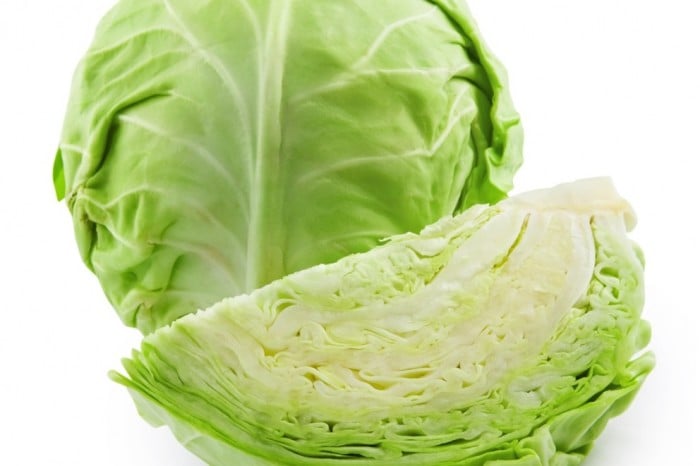
In addition to the stew, you can cook: zrazy, cabbage casserole, lazy cabbage rolls and other dishes.
If a child over one year old eats little and poorly, you have to persuade or force him to eat another portion, watch the online course on restoring a healthy appetite. We eat with pleasure >>>
Soup recipe
- Rinse potatoes, pumpkin, carrots and broccoli thoroughly.
- Peel, remove seeds, break into inflorescences.
- Cut the vegetables into cubes.
- Place the pan on the fire and bring to a boil.
- Throw all ingredients into bubbling water.
- Now you can add green peas.
- Cooking over low heat is recommended for about 30 minutes.
- You can add vegetable oil to the finished dish. Try not to add salt to your food.
So we got to know what cabbage is, we learned about the variety of types of this vegetable. Now you know which variety is best to start feeding with this vegetable. The main thing is not to forget to introduce each new species into complementary foods in small portions and only if it is well tolerated, increase the portion of the baby. And don’t think that if your baby isn’t allergic to broccoli, then he won’t be allergic to white cabbage either. This is not so, among other things, different types are characterized by the presence of unique substances in their composition, and also have different effects on the baby’s body. I wish you to go through this difficult path with ease and that your baby’s diet can easily increase by a whole range of vegetables, which will essentially be one type - cabbage.
When your baby reaches six months of age, it's time to start trying solid foods. Each child’s body is very individual, so the introduction of new foods into a child’s diet should be approached with great caution. The baby needs time to get used to new tastes and sensations, and the structure of previously unfamiliar food.
The main thing you should start feeding your baby with is vegetables. Every family has certain preferences in the vegetable menu, and many parents are interested in when, for example, they can give their child cabbage.
From six months it is recommended to give vegetables such as potatoes, carrots, zucchini, broccoli, cauliflower. Of course, while children do not have teeth, vegetables should be given in the form of puree, then in finely chopped pieces, and at an older age, they should be given the opportunity to chew vegetables on their own.
Very healthy for children are Brussels sprouts, which are rich in vitamins and fiber, and are also a major source of potassium, manganese and other important minerals. Many people do not like the very peculiar smell released during boiling, so it can be baked in the oven. The prepared cabbage should be cut in half, sprinkled with a few tablespoons of olive oil and baked for about 30-40 minutes. For six-month-old babies, you can puree it using a blender or puree it through a sieve, while for older children, you can cut it into small pieces and mix it with puree or yogurt.
Cauliflower, which contains easily digestible proteins, vitamins, mineral salts and carbohydrates, may also be a useful product in a child’s diet. It is important to consider that it is better to buy cauliflower fresh, not frozen, in order to avoid a significant loss of essential nutrients. To prepare a tasty and nutritious cauliflower puree, the inflorescences are first boiled and then thoroughly crushed in a blender until smooth.
Sauerkraut deserves special attention in baby food. Despite the rich content of vitamins, fermented foods contain fermentation elements. Again, much depends on the individual characteristics of the child’s body, but it is recommended to start giving sauerkraut to children no earlier than two years old, starting with one or two tablespoons.
A unique and healthy product is seaweed. It is in it, like no other product, that it contains iodine, amino acids, macro- and microelements, which are so necessary for the healthy growth and development of the body. Children are recommended to eat seaweed from the age of two to three years.
Read other articles about children, their life, upbringing, and development.
Wonderful Brussels sprouts are not only tasty, but also very healthy. It is appropriate on a strict dietary table and in the nutritious diet of the expectant mother, and its versatile beneficial properties are preserved with any method of preparing the vegetable.
Recipes with cabbage for children
Cauliflower goes well with many vegetables, so the children's menu can be easily varied with tasty and healthy dishes. Below are some popular recipes.
To prepare the first dish you will need 2-3 inflorescences, a small potato, 20 grams of carrots, 20 grams of onions, 200 ml of water.
All ingredients must be thoroughly washed, peeled and cut. Bring a saucepan with water and potatoes to a boil on the stove, reduce heat and simmer for 7 minutes. Then add the remaining vegetables and cook for another 10 minutes. Pour the broth into a separate bowl, and mash the prepared soup ingredients with a masher or blender until smooth. Pour the broth into the puree, put it on the stove and boil.
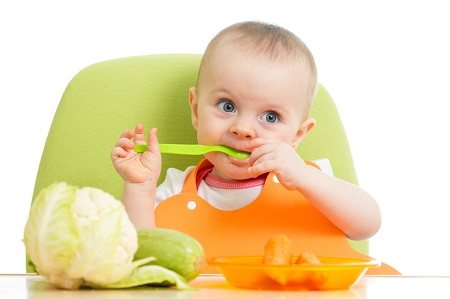
You can add 5 grams of butter or 1/4 chicken yolk to the soup.
You will need 2-3 inflorescences, potatoes, 300 ml of water, 20 grams of carrots, 2 tbsp. spoons of sour cream, 5 grams of butter.
Peel, rinse and cut the vegetables into small pieces. Cook the potatoes for about 7 minutes. Add cabbage, carrots and cook for 10 minutes. Pour a small amount of broth into a separate bowl. Chop the prepared vegetables, add sour cream and butter. If the soup is too thick, you can dilute it with broth. Place on the stove and bring to a boil.
We suggest you familiarize yourself with How to properly install the second body on the hive
You will need the following ingredients: 2 cauliflower florets and the same amount of broccoli, potatoes, 100 ml of milk, 5 grams of butter, 200 ml of water, salt to taste.
Wash the vegetables, peel and chop finely. Boil the potatoes for 7 minutes, then add the cabbage. Pour in milk, add salt, boil and cook for 10 minutes. Add oil at the end. If the baby knows how to chew, then there is no need to puree the dish.
To prepare you need 3-5 inflorescences, a tomato, a chicken egg, 100 grams of cheese, 50 ml of milk, butter, salt to taste.
Wash the cabbage, divide into small florets and throw into boiling water and cook for 2 minutes. Next, pour into a colander to completely drain the water. Cut the inflorescences into pieces, place on the bottom of a baking dish, greased with butter, and place tomato cubes on top. Pour the eggs beaten with milk over the vegetables, add salt and sprinkle with grated cheese. Bake for 20 minutes in an oven preheated to 180 degrees.
How to freeze for the winter
Let's look at step-by-step instructions on how to prepare cauliflower at home for freezing:
- The head of cabbage must be thoroughly washed, divided into inflorescences, filled with cold water and left to soak for half an hour to get rid of possible insects.
- After this, the cabbage must be kept for 5 minutes in new cold water, but with the addition of the juice of half a lemon. This will preserve its color, juiciness and most of the nutrients.
- Place a pot of water on the stove, bring to a boil and add the inflorescences to it. Cook for 5 minutes, remove with a slotted spoon and place in a bowl of ice water.
- Place the vegetables on a tray and let them dry thoroughly. Place into bags and place in the freezer.
Frozen cauliflower can be stored for no more than 6 months.
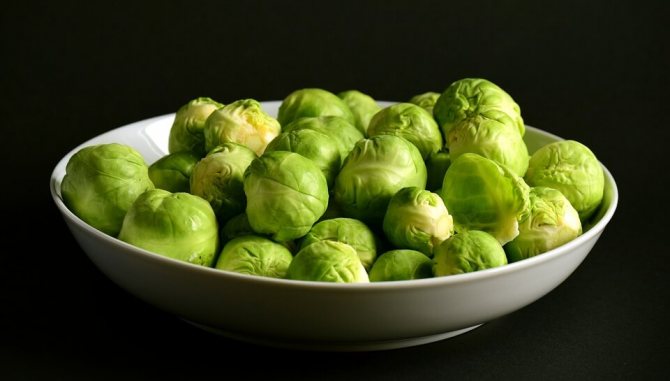
White cabbage puree is perfect for a first acquaintance. It's easy to prepare:
- Clean the head of cabbage from the top leaves and wash.
- Cut into small thin strips.
- Place the cut pieces in an enamel bowl and fill them with water.
- Cover the pan with a lid and leave the vegetable to cook on the stove over low heat (you can use a slow cooker or double boiler instead of a stove). If the cabbage is purchased, drain the first broth.
- When the vegetable is cooked, discard it in a colander.
- Using a blender or sieve, grind the boiled leaves. Add a few tablespoons of cabbage broth or boiled water to the resulting puree to achieve the desired consistency.
- Now you can give food to the child.
Complementary feeding with white cabbage causes disappointment for many mothers, since it often causes increased gas formation in the baby. But the beneficial properties of the vegetable do not allow us to completely reject this product. In this situation, it is common sense to combine cabbage with other foods (but only after the baby has successfully adapted to them). Various combined vegetable purees and soups are very healthy for the child and are also safe.
Ingredients: potatoes - 1 piece, carrots - 0.5 pieces, zucchini - 100 grams, white cabbage - 100 grams, pumpkin - 100 grams, water.
Preparation: Peel, wash the vegetables and chop them. Place the chopped vegetables in a saucepan and add enough water to cover them. Place the pan on the stove. After boiling, vegetables should be cooked for 20-30 minutes (until ready). Remove the vegetables from the water and puree them in a blender. If necessary, add a little vegetable broth to the puree.
Cabbage soup for kids
- Chicken (breast or fillet) – 0.2 kg;
- Cabbage - 1⁄4 fork;
- Potatoes – 1 tuber;
- Onion – 1⁄2 pcs.;
- Carrots – 1/2 fruit;
- Olive oil – 1 teaspoon. spoon.
Shchi is the most popular white cabbage soup. This recipe is suitable for babies already 1-1.5 years old. For older children, you can add tomatoes and bell peppers to the dish, and use bay leaves when cooking. Here we use a minimum of ingredients and spices.
Cook the chicken separately. After boiling, it is advisable to remove the broth and add fresh water. After boiling again, do not forget to remove the foam. Place the boiled chicken separately, finely chop the cabbage and add to the broth, leave to cook. Meanwhile, peel the vegetables, finely chop the potatoes and add to the cabbage.

Chop the onion and grate the carrots. Place the vegetables in the soup, add a little salt and stir. Finely chop the boiled chicken and add to the vegetables. Add olive oil and cook until potatoes and cabbage are done. A couple of minutes before the soup is ready, you can sprinkle it with chopped fresh herbs.
Stewed cabbage
- Cabbage – 1 leaf;
- Butter – 80 g;
- Milk – 100 ml;
- Water – 50 ml.
Finely chop the cabbage leaf, pour in a mixture of milk and water, and simmer. When it softens, lightly add salt and simmer for another three minutes. Add a piece of butter and serve with mashed potatoes or rice porridge. This dish is suitable for the first feedings of cabbage at 8-10 months. For older children, stewed cabbage can be served as a side dish for meat or fish.
Casserole
- Cabbage – 1 leaf;
- Semolina - 1 table. spoon;
- Egg – 1 pc.;
- Milk – 100 ml;
- Sour cream – 50 ml.
Finely chop the cabbage and simmer in milk until soft. Add salt to taste and carefully add semolina, then cook for six to seven minutes. Place the resulting mass in a baking container. Boil the egg separately, peel and cut, add to the cabbage mixture. Bake at 180 degrees for five minutes. Grease the finished dish with sour cream. The result is a tasty and original casserole that will diversify your child’s diet.
- Beef – 0.4 kg;
- Rice – 50 g;
- Cabbage – 0.4 kg;
- Carrots – 1 pc.;
- Egg – 1 pc.;
- Onion – 1 pc.;
- Tomatoes – 1 pc.;
- Sour cream – 1/2 cup.
Peel the vegetables, finely chop the onion, and grate the carrots. We turn the cabbage together with the meat through a meat grinder, then the minced meat will turn out tender and soft. If you are using ready-made minced meat, simply chop the vegetable finely. Stew carrots and onions in a small amount of water. Mix the vegetables with the minced meat, add the rice and add the egg, add a little salt.
Leave the resulting mass in the refrigerator for an hour, after which we form small cutlets and place on a baking sheet. Peel the tomato and grind in a meat grinder. Mix the tomato mass with sour cream, pour in a glass of warm boiled water and stir. Fill the cabbage rolls with sour cream sauce and bake for forty minutes at 180 degrees.
- Chicken – 0.4 kg;
- Cabbage – 0.2 kg;
- Zucchini – 1 pc.;
- Potatoes – 3 pcs.;
- Carrots – 1 pc.;
- Tomatoes – 2 pcs.
We suggest you read: Is it possible to eat rose hips with seeds?
Pour water into a container with thick and high walls. Cut the bird into small pieces and place in heated water. Cut potatoes, cabbage and carrots and add to chicken. Simmer covered for seven minutes. Peel and cut the zucchini, peel and chop the tomatoes. Add the remaining ingredients to the chicken and vegetables, add salt and pepper if desired, mix and simmer for another forty minutes. And instead of chicken, you can take turkey or rabbit.
- Turnip – 200 gr;
- Potatoes – 200 gr;
- Carrots – 200 gr;
- Cabbage – 200 gr;
- Cucumbers – 250 gr;
- Lettuce leaves – 120 g;
- Green onion – 100 gr;
- Eggs – 3 pcs.
How to make puree for your child yourself?
Boil in a saucepan
If the first complementary feeding occurs in the winter or early spring months, then it is better to take care of the vegetable diet in advance and freeze the products. You can freeze cabbage either fresh or after blanching:
- Freezing fresh vegetables. Rinse fresh vegetables well under running water and leave for 20 minutes in warm salt water to disinfect and preserve color. Then rinse the vegetables again, dry with paper towels and place in portions in plastic containers or bags.
- Blanching. Place the washed inflorescences in boiling unsalted water for 5 minutes. Then remove the vegetables and immediately transfer them to ice water. You also need to keep the cabbage in cold water for 5 minutes. Afterwards, you need to dry the inflorescences and place them in portions in bags.
Cauliflower puree is the right choice for complementary feeding. Vegetables teach your baby to eat healthy foods and provide him with the necessary vitamins. Mothers who feed their infants vegetables do not face the problem of how to feed their already matured child “healthy foods.”
It is especially not recommended to give it as the first product that the baby tries. To begin with, the baby needs to be introduced to purees from other vegetables (zucchini, potatoes, pumpkin) or porridges, and then, if desired, you can introduce white cabbage to the menu.
We suggest you read: What is the difference between broccoli and cauliflower?
Cauliflower is much better absorbed and is easily digested by a child's stomach. If white cabbage causes bloating, then its colored relative can serve as an alternative. You can introduce it into your baby's complementary foods at 4 months for artificial babies and at 6 months for infants.
Many pediatricians recommend starting complementary foods with broccoli. This vegetable is healthy and tasty. In addition, it rarely causes bloating and gas formation. This is why broccoli puree is becoming increasingly popular.
However, the frozen version is suitable for winter, when there are no fresh vegetables, but only imported ones. It’s better to freeze several bags of cauliflower inflorescences from your own garden in the summer than to buy fresh, but imported ones.
To prepare the simplest cabbage puree you will need:
- Cauliflower – 50 grams;
- Water or breast milk – 2-3 spoons.
Rinse the cauliflower thoroughly, remove dirty spots and disassemble the head into inflorescences. Throw the inflorescences into boiling water and cook for 20-30 minutes until softened. After that, put them in a blender bowl, add a little water or breast milk and blend until smooth.
When your baby gets acquainted with other products, you can add new ingredients to cauliflower puree:
- egg yolk;
- butter;
- potato;
- broccoli and other vegetables.
Ingredients:
- cauliflower - several inflorescences;
- water – 2-4 spoons;
- olive or flaxseed oil - 0.5 teaspoon
Pour water into the multicooker bowl and place a wire rack on top for steaming dishes. Place the cauliflower florets on the grill and close the lid. Set the steam mode for 30 minutes.
Grind the finished inflorescences with a blender, add water and oil (you can choose any oil, the main thing is that it is natural, unrefined and pure). Stir the puree and feed the baby. You can add some potatoes.
Often, the manufacturer, in addition to the required vegetables and water, adds foreign ingredients to the product.
- Hipp, Fleur Alpine, Nutrica, Bebivita foods contain rice flour.
- Hipp and Bebivita purees also contain rice starch, which can cause allergies in some children.
- Some manufacturers add salt to food to make it tastier. But for babies under one year old, you should not add salt to food.
In addition, buying ready-made baby food is not always profitable. The price range for brands ranges from 35 to 55 rubles. For example:
- Baby puree with cauliflower from the Hipp brand costs about 44 rubles;
- The manufacturer Gerber offers the product for 53 rubles;
- "Frutonyanya" is one of the cheapest analogues. The price of one jar is 32-35 rubles;
- “Babushkino Basket” costs 39-42 rubles.
How to introduce seaweed into your diet
Babies who are breastfed can try kale at 6 months. At this point, they are already familiar with zucchini, cauliflower, potatoes and some cereals. A vegetable unfamiliar to the baby can be introduced only 1 week after the introduction of the previous product. It is important that the absorption of the previous new product occurs without allergic reactions.
White cabbage is hypoallergenic; it almost never causes allergies in children. But still, the baby may have an individual intolerance to the product, so mom should be on guard for 1 day after the first serving of cabbage puree. By the way, the very first portion of puree should not be more than 0.5 teaspoon. If there is no negative reaction from the body, then in the future the portion is doubled each time, gradually increasing to 150 grams at a time.
When can you give combined purees with cabbage? For the first couple of months, the baby is given cabbage puree without the addition of milk, salt, butter or other ingredients. When the child has adapted to the new vegetable, it is time to combine it with other products (which have already been introduced into the child’s diet). So, cabbage goes well with potatoes, carrots and zucchini.
At what age is white cabbage introduced into complementary foods? It should be noted that the introduction of white cabbage too early (before 6 months) is not recommended, since it may be too heavy a product for the child’s small, unadapted stomach. For bottle-fed babies, cabbage is introduced at 5 months of life, and for infants - from 6 months.
Raw vegetables can be given to children from 3 years of age, provided that they do not have diseases of the gastrointestinal tract.
Sea kale can be introduced into a child’s diet no earlier than 2 years of age. Despite its rich composition, the baby’s digestive system may not be able to cope with it. Too large a portion or frequent use can cause diarrhea.
There is rarely an allergy to kelp. But if a child has iodine intolerance, then seaweed is contraindicated for him.
The benefits of Brussels sprouts during pregnancy and for baby food
Once upon a time, the property of Brussels sprouts to have a positive effect on female reproductive functions was known in folk medicine, but today this has been scientifically confirmed, as well as the fact that this vegetable stimulates the production of the female hormone estrogen.
During the happy time of pregnancy, this variety of cabbage is useful for increasing vigor, toning the whole body and strengthening it before physical activity, to which expectant mothers are known to be very sensitive.
Also, Brussels sprouts can reduce swelling and normalize the water-salt balance, reduce the manifestations of toxicosis, and remove toxins from the body.
Folic acid is one of the main elements of its composition. It is invaluable for preventing fetal malformations, and during the period of feeding the baby, it reliably supports his just developing immunity and central nervous system.
The benefits of Brussels sprouts are also invaluable for baby food; moreover, as part of a variety of purees, they can appear on a baby’s menu as early as 6 months of age.
Stewed cabbage for children
How to cook cabbage for a child so that it is healthy and tasty? The best option is stewed cabbage. This dish is suitable for children over one year old. In addition, you can add other vegetables and meat to the stewed cabbage leaves.

To prepare the dish you will need:
- Cabbage leaves;
- butter;
- water or chicken broth.
The amount of ingredients is calculated individually. It is not recommended to give small children food from the refrigerator. Therefore, you don't need to cook a lot.
The first step is to wash and finely chop the vegetable. There is no need to leave the stalk. Heat butter (2-3 teaspoons) in a frying pan. Next add the shredded cabbage leaves. Then simmer under a closed lid, adding a little chicken broth or water.
Possible consequences after consumption
Sometimes cauliflower causes a negative reaction from the body.
It can be observed against the background of diseases of the digestive tract, genetic predisposition, intensification of the intestinal bacterial microflora, or excessive consumption of the product. In some cases, an allergy occurs not to the cauliflower itself, but to chemicals that were used during its cultivation or to increase its shelf life.
Manifestations of the reaction are individual (rashes, redness on the skin, urticaria, severe itching, diarrhea, abdominal pain, conjunctivitis, rhinitis).
